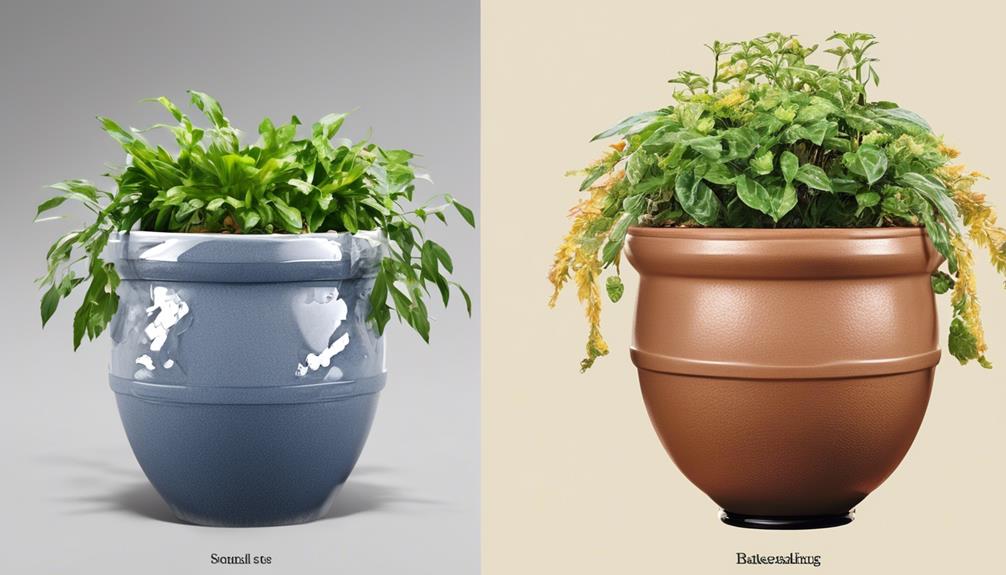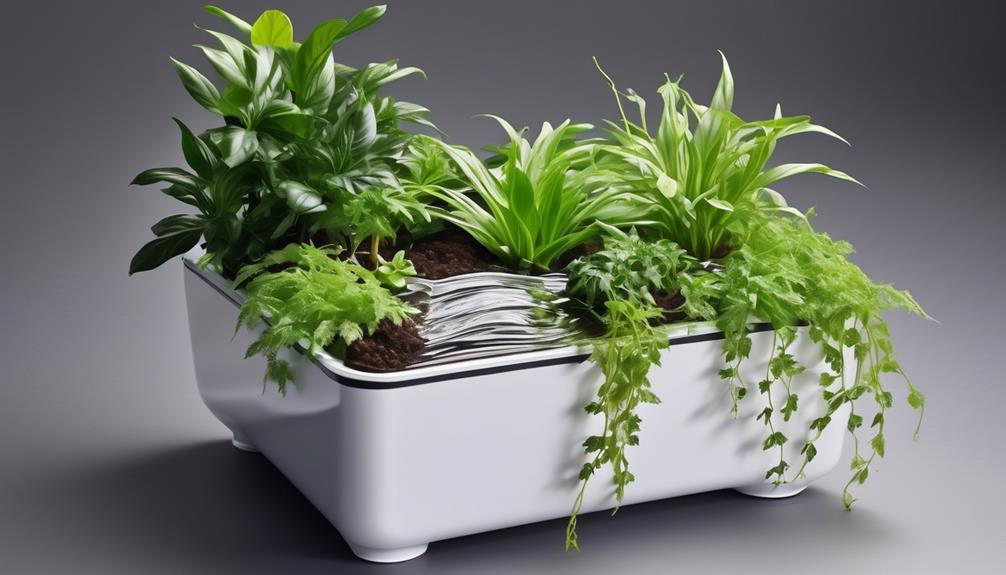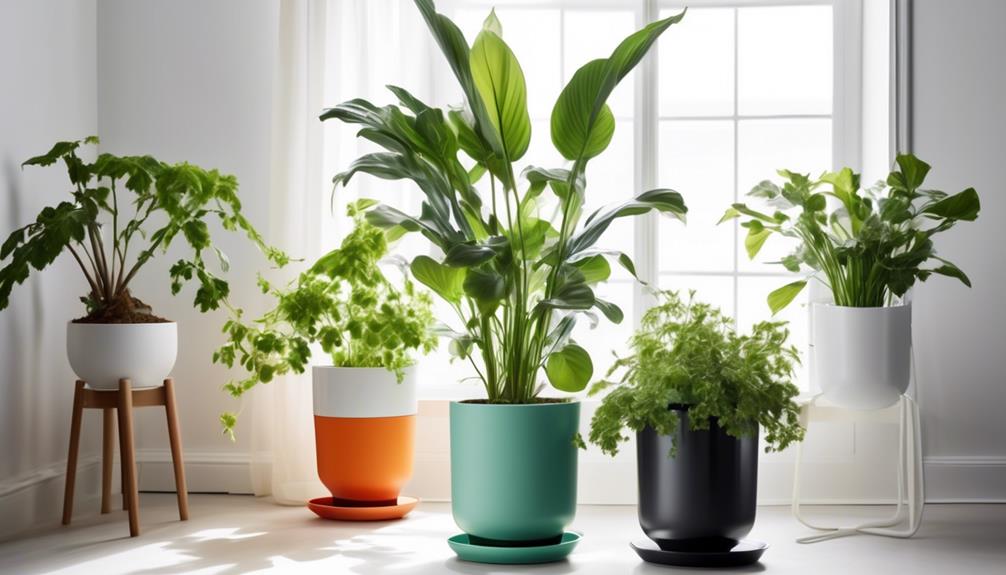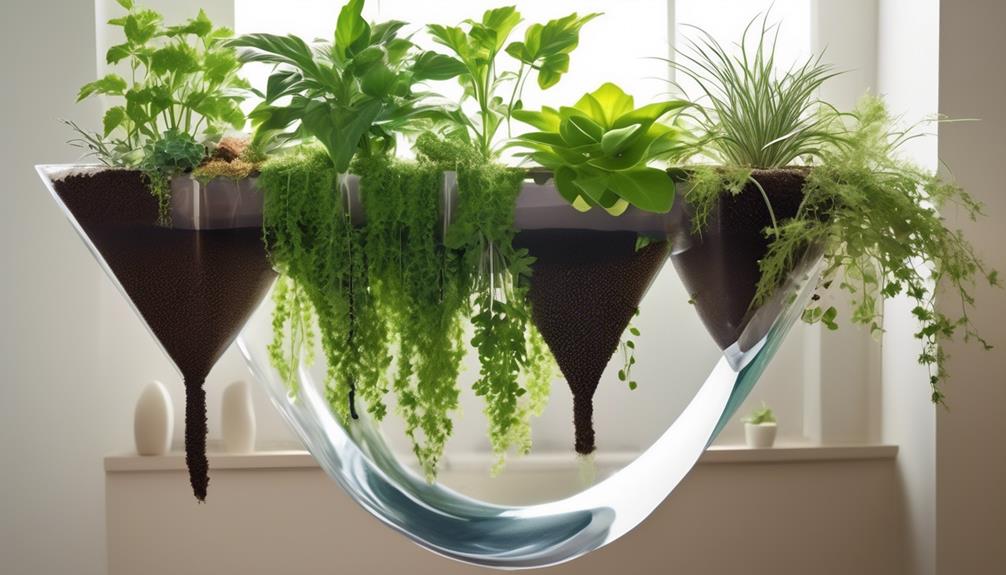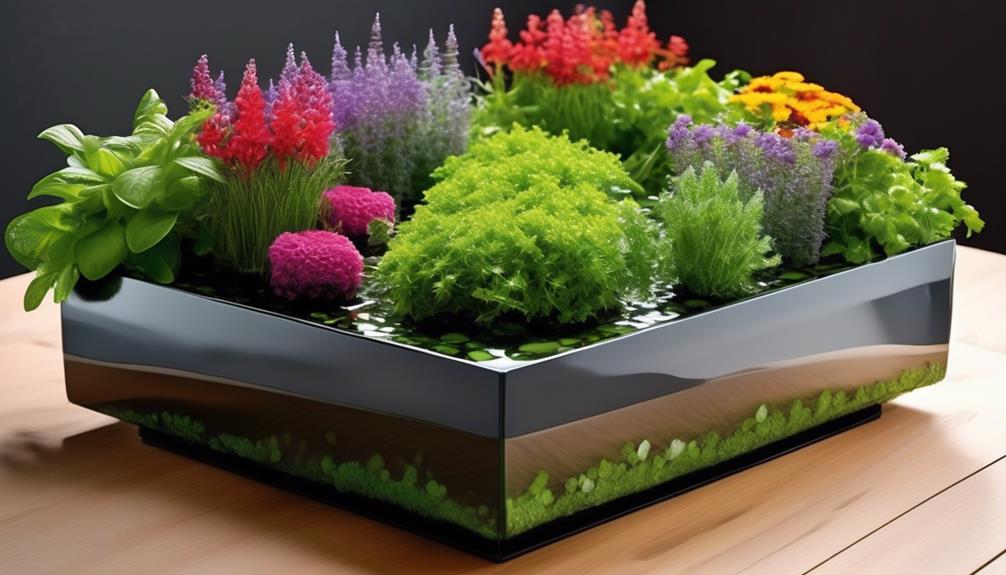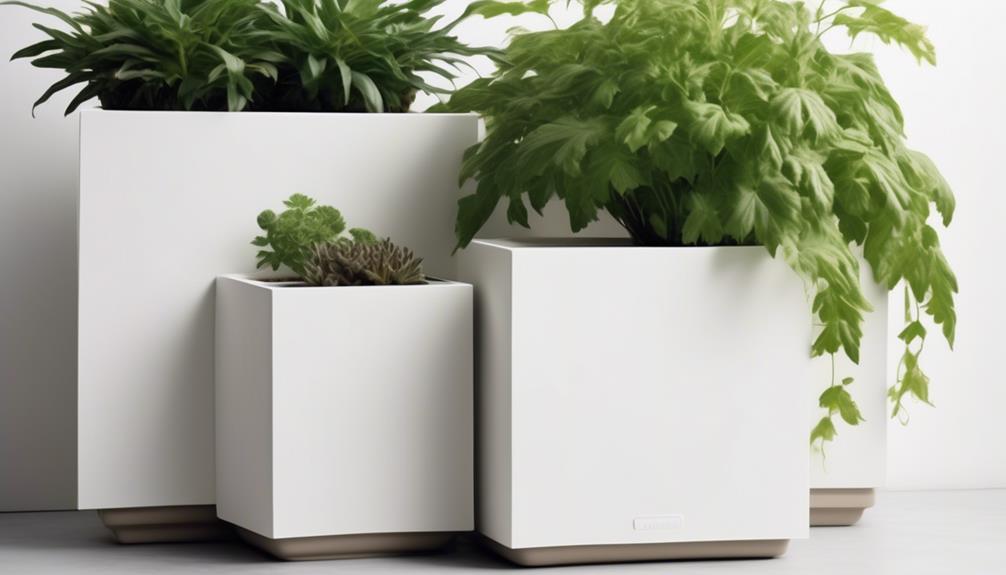We have all had that moment of sudden realization when we realize it has been several days (or possibly even weeks) since we last watered our plants.
It's a common struggle for many of us who love having greenery around, but have busy schedules.
Now, you may have heard about self watering plant pots as a solution to this problem, but are they really any good?
Well, let's just say there's more to these pots than meets the eye, and whether they're worth the investment might surprise you.
Key Takeaways
- Self watering plant pots provide consistent and controlled water supply, promoting healthy growth and reducing the risk of overwatering or underwatering.
- These pots support the development of strong root systems and contribute to the overall environmental impact of gardening.
- They save water and time for the gardener, making plant care more convenient.
- When choosing self watering pots, it is important to evaluate the specific needs of plants and the usage environment, consider the material durability, find a balance between affordability and quality, and take aesthetic appeal into account.
Benefits of Self Watering Plant Pots
Self watering plant pots provide a consistent and controlled supply of water to the plants, promoting healthy growth and reducing the risk of overwatering or underwatering. This system ensures that plants receive adequate moisture at all times, which is crucial for their long term sustainability. By maintaining optimal moisture levels, self watering pots support the development of strong and robust root systems, resulting in healthier and more resilient plants. This not only benefits the individual plants but also contributes to the overall environmental impact of gardening.
In terms of long term sustainability, self watering plant pots offer several advantages. They help conserve water by delivering it directly to the plant roots, minimizing evaporation and runoff. Additionally, these pots can be made from eco-friendly materials, further reducing their environmental impact. The controlled water supply also reduces the frequency of watering, saving time and energy for the gardener.
Considering the environmental impact, self watering plant pots demonstrate efficiency in water usage and contribute positively to the overall sustainability of gardening practices.
How Self Watering Pots Work
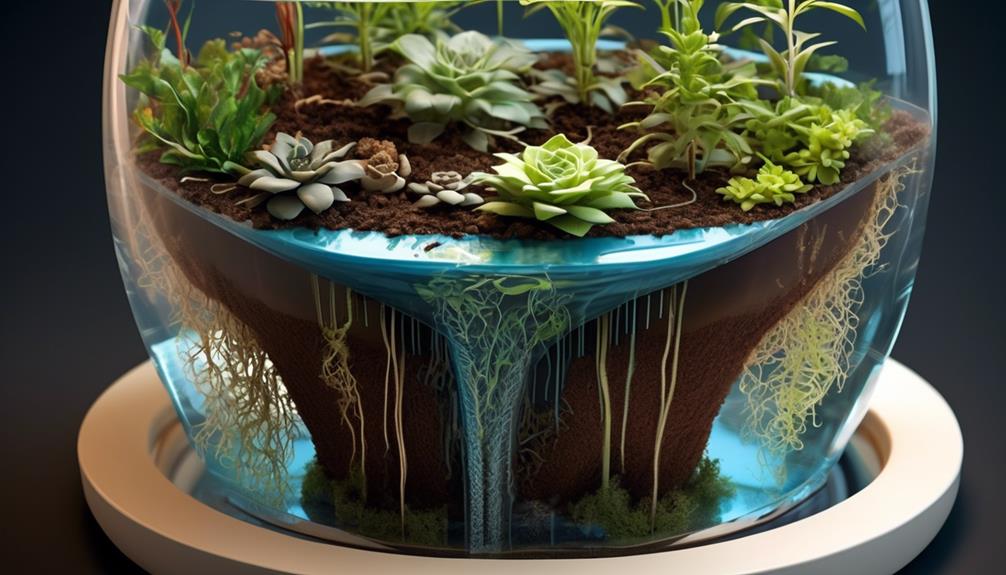
We can understand the function of self watering pots by examining the way in which they utilize a reservoir to provide a controlled and consistent supply of water to the plants. These pots typically consist of two main compartments: a pot for the plant and a reservoir for water. A wick or capillary action mechanism connects the two compartments, allowing water to be drawn up into the soil as needed. The table below provides a comparison of traditional watering methods with self watering pots.
| Aspect | Traditional Watering | Self Watering Pots |
|---|---|---|
| Watering Frequency | Manual, irregular | Controlled, consistent |
| Plant Health | Prone to over/under watering | Maintains optimal moisture levels |
Self watering pots regulate watering frequency by ensuring that the soil receives water as needed, reducing the risk of both over and under watering. This consistent moisture level promotes plant health by preventing water stress and waterlogging, providing an optimal environment for root growth and overall plant vitality. Therefore, self watering pots offer a reliable solution for maintaining plant health through controlled and consistent hydration.
Considerations Before Buying
When considering the purchase of self watering plant pots, it's important to evaluate the specific needs of the plants and the intended usage environment to determine if this watering method is suitable. Firstly, one should assess the material durability of the self watering pots. Look for options made from high-quality, long-lasting materials such as UV-stabilized plastic or ceramic, ensuring that the pots will withstand outdoor conditions or indoor use for an extended period.
Additionally, consider the price range, as these pots can vary widely in cost. It's important to find a balance between affordability and quality to make a worthwhile investment.
Furthermore, eco-friendly options should be taken into account. Some self watering pots are made from sustainable or recycled materials, reducing environmental impact.
Aesthetic appeal is another crucial factor to consider, especially for indoor plants. Choose pots that complement the interior decor and enhance the overall visual appeal of the space.
Types of Self Watering Pots
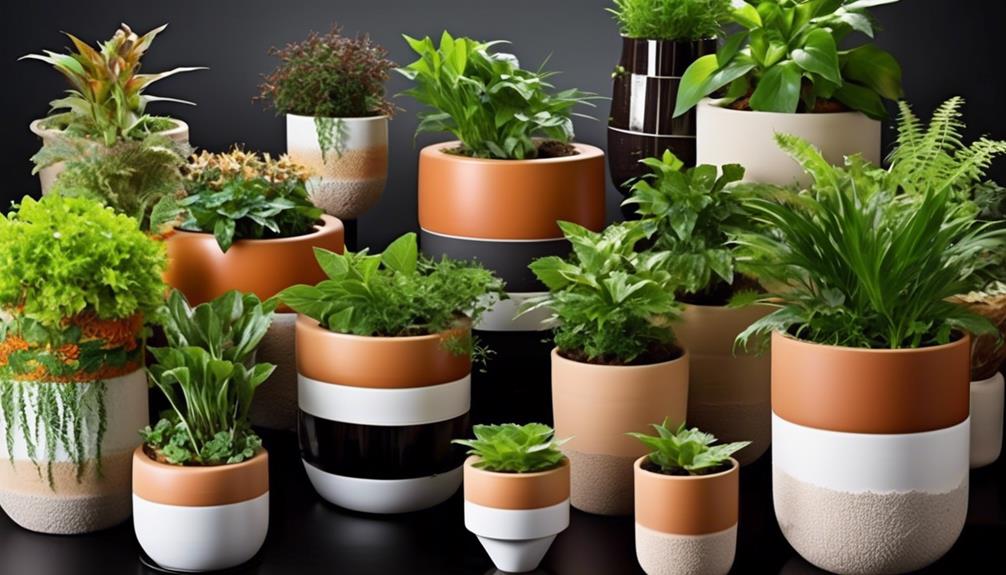
Considering the material durability, price range, eco-friendliness, and aesthetic appeal of self watering pots, it's important to understand the various types available in the market to make an informed decision.
When evaluating self watering pots, it's crucial to consider the materials used, as they directly impact the pot's performance and longevity. Some of the best materials for self watering pots include:
- Plastic: Affordable and lightweight, plastic self watering pots are a popular choice for indoor use. They're available in various colors and designs, offering versatility and aesthetic appeal.
- Ceramic: Known for their durability and elegant appearance, ceramic self watering pots are ideal for both indoor and outdoor settings. They come in a wide range of styles, making them suitable for different decor preferences.
- Terracotta: These pots are excellent for plant health as they allow for better aeration and moisture regulation. They're affordable, eco-friendly, and provide a natural look.
When considering popular self watering pot brands, options such as Lechuza, Bloem, and Algreen are well-regarded for their quality and innovation in self watering pot design. These brands offer a wide range of styles and sizes to cater to different plant care needs.
Tips for Using Self Watering Pots
To ensure optimal plant health and growth, it is important to follow specific guidelines for effectively utilizing self watering pots. Proper maintenance and understanding plant compatibility are crucial for the successful use of these pots. Here are some essential tips for using self watering pots:
| Maintenance Tips | Plant Compatibility |
|---|---|
| Regularly check the water level indicator to ensure it is functioning properly. | Choose plants that thrive in consistently moist soil, such as ferns, peace lilies, and spider plants. |
| Clean the pot and reservoir regularly to prevent algae or mold growth. | Avoid using self watering pots for plants that prefer dry soil, such as cacti and succulents. |
| Monitor the soil moisture periodically to adjust the watering frequency as needed. | Research the specific water requirements of each plant and adjust the watering system accordingly. |
| Use a balanced fertilizer to supplement the nutrients in the soil. | Consider the size of the pot in relation to the plant's root system to ensure proper oxygenation. |
| In case of any issues, refer to the manufacturer's instructions for troubleshooting. | Be mindful of the pot's material, as some materials may retain more moisture than others. |
Frequently Asked Questions
Can Self Watering Plant Pots Be Used for All Types of Plants, Including Flowers, Herbs, and Vegetables?
Self watering plant pots can be used for a variety of plants, including flowers, herbs, and vegetables.
The container gardening method, paired with self watering technology, provides optimal conditions for plant growth while conserving water.
This system ensures that plants receive consistent moisture, promoting healthy root development and overall vitality.
The versatility of self watering plant pots makes them a practical and efficient choice for a wide range of plant species.
Are Self Watering Plant Pots Suitable for Outdoor Use, or Are They Better for Indoor Plants?
When considering outdoor vs. indoor use, self-watering plant pots can be suitable for both environments.
The choice of plant pot materials is crucial for durability and weather resistance. Outdoor pots must withstand harsher conditions and UV exposure, whereas indoor pots focus more on aesthetics and moisture retention.
Understanding the specific needs of your plants and the environment they'll be in is key to making the right choice.
Do Self Watering Plant Pots Require Any Special Maintenance or Cleaning to Ensure They Continue Working Effectively?
Maintenance tips for self-watering plant pots include:
- Regular cleaning of the reservoir and wicking system to prevent clogs and mold growth.
- Use a mild soap and water solution to clean the reservoir.
- Replace the wick annually for optimal performance.
When choosing plants for self-watering pots:
- Opt for plants with moderate water needs to avoid over-saturation and root rot.
- Adjust the watering frequency based on plant type and environmental conditions for best results.
Can Self Watering Plant Pots Be Used in Conjunction With Traditional Watering Methods, Such as Manual Watering or Using a Drip Irrigation System?
Traditional watering methods, like manual watering or drip irrigation, can be used alongside self-watering pots. This allows for flexibility in watering techniques, catering to specific plant needs.
When combining self-watering pots with alternative methods, it's crucial to monitor soil moisture levels to avoid over-watering.
Integrating these systems can provide a comprehensive approach to plant care, whether in hydroponic systems or traditional soil-based gardening.
Are There Any Potential Drawbacks or Limitations to Using Self Watering Plant Pots That Consumers Should Be Aware of Before Making a Purchase?
When considering potential drawbacks and limitations of self-watering plant pots, it's important to note their maintenance requirements and effectiveness with traditional watering methods.
While these pots can be convenient, they may not suit all plant species and can lead to overwatering. Understanding the specific needs of your plants is crucial.
Additionally, traditional watering methods may need to be adjusted to ensure compatibility with self-watering pots.
What are the Benefits of Using Self-Watering Plant Pots?
Self watering plant pots are a game-changer for plant parents. These pots ensure that your plants get the right amount of water without the risk of over-watering. They also reduce the frequency of watering, making it easier to maintain a healthy and lush garden.
Conclusion
In conclusion, self watering plant pots offer numerous benefits such as reducing water waste and providing consistent moisture to plants. According to a study by the University of Colorado, self watering pots can reduce water usage by up to 80% compared to traditional watering methods.
With proper consideration and maintenance, self watering pots can be a great investment for both novice and experienced gardeners.

